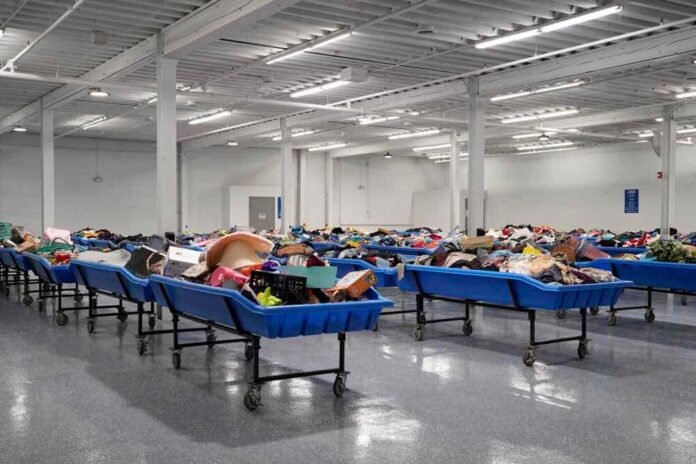As the global textile waste crisis intensifies, governments worldwide are adopting forward-thinking policy solutions, such as Extended Producer Responsibility (EPR) programs, to combat this urgent issue. In light of these efforts, the Secondary Materials and Recycled Textiles Association (SMART) is urging local officials to champion the responsible use of clothing collection bins, which are indispensable for effective textile waste management. These bins help extend the life cycle of textiles, divert them from landfills, and drive progress toward a sustainable, circular economy.
SMART, the leading trade association for the textile reuse and recycling industry, represents members who operate clothing collection bins designed to recover and repurpose textiles. These bins not only advance sustainability efforts but also provide significant benefits to communities, strengthen local economies, and mitigate environmental impacts. By fostering their responsible use, local officials can play a pivotal role in tackling the textile waste crisis while supporting economic and social progress.
The Growing Textile Waste Problem
Public officials in the United States and across the globe are increasingly recognizing the urgent need to address textile waste. According to the U.S. Environmental Protection Agency (EPA), textiles contribute nearly 17 million tons of waste annually—about 6.3% of the total waste stream—with only a small fraction being recycled. Yet, nearly 95% of discarded textiles can be reused or recycled.Reusing and recycling textiles not only reduces waste but also has a greater impact on lowering greenhouse gas emissions compared to recycling materials like plastic, glass, or yard waste.
To address this challenge, states like California have enacted bold measures, such as EPR legislation mandating large-scale take-back programs for used textiles. Similarly, states like New York and Washington, along with federal policymakers, are exploring comparable initiatives aimed at dramatically increasing textile diversion rates. Achieving these ambitious goals will require unified, collaborative efforts from all levels of government and active participation from all stakeholders across the textile reuse and recycling infrastructure.
The Role of Clothing Collection Bins
Despite far-reaching policy efforts aimed at curbing textile waste, some municipalities have enacted ordinances that ban for-profit clothing collection bins or impose burdensome regulations, effectively hindering their operation. Such counterproductive measures undermine these efforts to reduce textile waste. Clothing collection bins provide critical infrastructure for textile waste reduction while offering significant benefits:
1) Advancing Textile Waste Reduction Goals
The textile reuse and recycling sector diverts approximately 4 billion pounds of clothing annually from landfills and clothing collection bins are a key component of this effort, significantly boosting recovery rates. By making textile donation and recycling more accessible, these bins ensure that a larger proportion of textiles are repurposed, recycled, or reused, directly supporting sustainability goals.
2) Providing Convenient Textile Waste Collection
Collection bins offer an easy and accessible option for consumers to donate unwanted textiles, filling a gap where brick-and-mortar donation sites may not be available. This convenience helps reduce the likelihood of textiles being discarded in household trash, diverting them from landfills.
3) Creating Jobs in Local Economies
The operation of clothing collection bins supports employment in logistics, warehousing, sorting, and recycling, bolstering local economies while advancing a circular economy. These jobs provide opportunities for skill development and career growth, strengthening the social and economic fabric of communities.
4) Providing Revenue for Charities
Many clothing collection bin operators partner with nonprofit organizations through revenue- sharing agreements, providing consistent and needed funding for vital community programs. These partnerships enhance charitable efforts while advancing sustainability goals, making a tangible difference in local communities.
5) Reducing Costs for Local Governments
By decreasing the volume of textiles sent to landfills, clothing collection bins help municipalities lower landfill tipping fees—an increasingly significant expense for local governments. Properly managed bins provide a cost-effective solution for textile waste management, reducing financial burdens on taxpayers.
The Need for Balanced Policies
While ensuring that clothing collection bins are responsibly managed is essential—addressing concerns like illegal dumping and proper maintenance—overregulation can undermine their effectiveness. SMART members adhere to a robust Clothing Collection Bin Code of Conduct, which sets clear standards for responsible operation. Excessive permitting fees, overly restrictive placement requirements, and unnecessary administrative hurdles risk discouraging operators, ultimately reducing the availability of this essential service. Local governments should instead adopt balanced policies that emphasize accountability, transparency, and collaboration with bin operators. Such an approach addresses community concerns while preserving the benefits these bins offer.
SMART urges local governments to recognize the critical role clothing collection bins play in addressing the textile waste crisis. By supporting their responsible use, municipalities can drive sustainability, create economic opportunities, and strengthen community programs.



